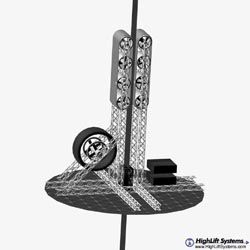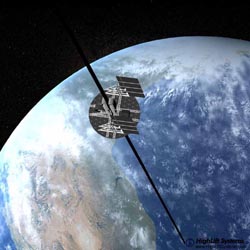|
In this issue of NanoNews-Now Editor Rocky Rawstern covers ongoing Space Elevator (SE) issues, via interviews with Dr. Bradley C. Edwards, Michael J. Laine, Dr. Thomas L. McKendree. Further interviews with Dr. David Tomanek, Dr. J. Storrs Hall, and Dr. K. Eric Drexler provide alternate viewpoints.
Off the main topic: Dr. Pearl Chin (in the next in her monthly series) contributes an article titled P-O'd At IPO's or 'Why the Nanosys IPO now would have been bad for Nanotech'.
Join us as we present "The Space Elevator"
|
 Would knowing the status of patents and patents pending coming out of universities benefit your company? Would having a single database within which to learn how to contact the right person at each technology transfer office be useful?
Would knowing the status of patents and patents pending coming out of universities benefit your company? Would having a single database within which to learn how to contact the right person at each technology transfer office be useful?
Nanotechnology Now is pleased to offer the NanoTech-Transfer Monthly Report and Database.
The NanoTech-Transfer product is an excellent tool, as it provides up to date information on what institutions and what individuals are actively involved in filing nanotechnology intellectual property. It provides me with the information I need to stay in touch with the leaders in the field. Great product.
—Douglas W. Jamison, Vice President Harris & Harris Group Inc. hhgp.com
A year's subscription includes 12 issues of our monthly report published on the last Friday of the month, and access to our patent database.
NanoTech-Transfer Patent Database
Full search Database - search by tech-sector, inventor, institution, application, patent number or date.
NanoTech-Transfer Report
Each monthly issue of the NanoTech Transfer Report delivers detailed information on the latest nanotech patents and patents pending from individuals, universities and research institutes from around the world.
Click Here For Details
|
|
Table of contents:
Bradley C. Edwards
Michael J. Laine
K. Eric Drexler
Thomas L. McKendree
David Tomanek
J. Storrs Hall
Pearl Chin
Quotes
Useful Links
Next Issue
Glossary
NanoStrategies
NanoTech-Transfer
NanoNews Digest
About Us
Contact
|
NanoNews-Now Editorial Calendar
|
|
Nov '04 |
Investments |
|
Dec '04 |
Self Assembly |
|
Jan '05 |
Patents |
|
Tentative Schedule 2005 |
|
Feb '05 |
MNT |
|
Mar '05 |
Memory and Chip Tech |
|
Apr '05 |
Jobs |
|
May '05 |
Education |
|
Jun '05 |
Tools |
|
Jul '05 |
Investments |
|
Aug '05 |
Security |
|
Sep '05 |
Life Extension |
|
Oct '05 |
Military |
|
Nov '05 |
Materials |
|
Dec '05 |
Possible Futures |
|
The Space Elevator
Applying tiny tech to humankind's journey to the stars
AKA: The Heavenly Funicular, Space Tether, Skyhook, Orbital Railroad, Beanstalk, Space Fountain, and Konstantin Tsiolkovsky's "Celestial Castle"
|

By Rocky Rawstern
|
One of humankind's grandest visions is to travel into space. Space travel represents both a technical challenge and the possibility of insuring the survival of the species. To date, we have managed manned missions to the Moon, and unmanned missions to several of our nearest planetary cousins. Space hotels and factories, off-world migration, and travel to distant Earth-like planets remains a potent yet unrealized dream.
Enter the Space Elevator
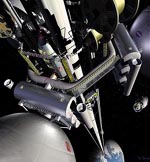
Concept of a space elevator as viewed from geostationary transfer station.
Courtesy of and © Copyright: Pat Rawling, Artist. Click to enlarge
|
The Space Elevator concept is simple: attach a cable or ribbon to a platform on Earth, run it up to Earth-orbit, attach elevators and an anchor weight to it, and use it to cheaply transport cargo and people to the fringes of space. A jumping-off point to the stars.
Can we do it?
A critical and as-yet-realized component of a successful space elevator is a super lightweight, super strong material. This material will be used to create a composite ribbon upon which elevators will ride carrying cargo and people. Traveling to geostationary Earth orbit, at around 36,000 kilometers, the ribbon would be attached to a ground platform at the Equator. The end in space would be attached to a counterbalance mass, probably using the ribbon-deployment equipment, or perhaps even a captured asteroid. Electromagnetic propulsion is a candidate for launch and delivery, technology which has already been jump-started by current high-speed railway efforts. Another possiblity is laser propulsion, which you will read more about in our interviews, below.
No ribbon material exists today that meets the strength-to-weight requirements. However, carbon nanotubes (CNTs) look promising, since in one form they may be as much as 100 times as strong as steel, at 1/6th the weight. The problem with CNTs is that to date, nobody has figured out a way to either create them in the thousands of kilometer lengths necessary, or to use them to create a composite material that also meets the requirements. Several recent discoveries do however appear to indicate that a composite material may be available in the next few years.
There are other hurdles, such as propulsion, terrorist threats, and avoiding space debris, hurricanes, and lightening, which we cover in the interviews below. All of these hurdles appear to be dealt with using existing technologies and extensions of existing technologies, and achievable in the short-term.
In an article titled Audacious & Outrageous: Space Elevators by science writer Steve Price, we learn more about one writer's views and vision of the Space Elevator. "Yes, ladies and gentlemen, welcome aboard NASA's Millennium-Two Space Elevator. Your first stop will be the Lunar-level platform before we continue on to the New Frontier Space Colony development. The entire ride will take about 5 hours, so sit back and enjoy the trip. As we rise, be sure to watch outside the window as the curvature of the Earth becomes visible and the sky changes from deep blue to black, truly one of the most breathtaking views you will ever see!"
Explained in simple terms by Price "A space elevator is essentially a long cable extending from our planet's surface into space with its center of mass at geostationary Earth orbit (GEO), 35,786 km in altitude. Electromagnetic vehicles traveling along the cable could serve as a mass transportation system for moving people, payloads, and power between Earth and space."
When built as conceived, the space elevator is predicted to greatly reduce the Earth-to-orbit costs of materials, devices, and people. The cost-per-pound to move into space will drop from a current NASA rate of $10,000-$40,000, to a forecasted rate of less than $100 (Ed. some say as little at $10 per lb. in the not-to-distant future). Figure you and your luggage weight 200 pounds - that's $20,000, a bit less than the reported $20M Dennis Tito paid to become the world's first space tourist." Additional and larger elevators, built utilizing the first, would allow large-scale manned and commercial activities in space and reduce lift costs even further." says Los Alamos National Laboratory.
When asked to estimate when the space elevator would be built, Arthur C. Clarke replied "Probably about 50 years after everybody quits laughing!" With the rapid increase in our understanding of nanotubes, coupled with our ability to ramp up their production and separate them, the laughter is rapidly dying down.
To learn more, visit the Institute for Scientific Research, and see their animation. See also The Space Elevator
Also visit the Useful Links section.
The Space Elevator
|

Bradley C. Edwards
|
NN: What advantages does having a SE bring to the country or business that builds the first one?
The simple answer is cheap, easy access to space. The real answer is much more complicated. It is like the railroads that had cheap, easy access to the American west or the sailing ships that gave their owners easy access across the seas. Their importance was the ability to access new resources, real estate, move unrestricted… For the space elevator it allows the owner the ability to hold the high-ground in conflicts; develop a new, economical and endless clean power supply and deliver it anywhere; at some level control of weather; own worlds and space that will provide new resources and in the long-term entirely new economies.
NN: What would the SE be used for? Off-world migration, space-tourism, asteroid mining, launching packages (such as satellites)? How does it benefit each?
Satellites initially, then solar power satellites, Earth imaging, some tourism (joy rides up a few hundred miles) and eventually it will open up space; the asteroids and neighboring planets. In many of these cases the SE makes it viable - there is a return on the investment. Without the SE solar power satellites cost too much to launch, tourism is restricted to the very rich, and colonizing space and the planets is restricted to large governments.
|
David Smitherman of NASA/Marshall's Advanced Projects Office has compiled plans for such an elevator that could turn science fiction into reality. His publication, Space Elevators: An Advanced Earth-Space Infrastructure for the New Millennium, is based on findings from a space infrastructure conference held at the Marshall Space Flight Center last year. The workshop included scientists and engineers from government and industry representing various fields such as structures, space tethers, materials, and Earth/space environments.
"This is no longer science fiction," said Smitherman. "We came out of the workshop saying, 'We may very well be able to do this.'"
link
|
NN: Who's for it, and why?
The people most supporting it at this point include the space community, general public and the media. These are the ones that have dreamed about having a real space program.
NN: Who's against it, and why?
We have really found no one that is 'against' it. Even Lockheed Martin has expressed strong interest in being involved. The critical point to remember is that my report and book (1) came out a little over a year ago and it takes years for federal agencies to get major programs into the budget process.
NN: Who's working on it now, and who's likely to be doing so in the next five to ten years?
I have turned into the default focus of the effort and have organized the three conferences to date. I am continuing a serious technical effort with the primary focus on developing the high-strength materials. Carbon Designs, my new company, has the funding and research partners to develop materials at 20 to 50 GPa in the next year and then go on to 100 GPa. Los Alamos National Laboratory also has a good effort that they are developing to examine some of the critical aspects such as radiation, dynamics and applications. The group that has the most funding is the Institute for Scientific Research, which I just left. They, in collaboration with Marshall Space Flight Center, have about $2M to study various aspects of the elevator such as the dynamics, ribbon design, systems engineering, dynamics, etc. Another group that is really starting to contribute is Spaceward Organization out of Mountain View led by Ben Shelef. Ben has been doing some deployment and ribbon design studies and is now organizing a ribbon climbing competition that should occur next June. The competition should be a very good event and demonstrate the viability of the engineering. This is also a precursor to a larger event they are planning. There are also a number of individuals such Blaise Glassand at MIT, and Andrew Price, that are working on different parts as well.
In 5 to 10 years, I am expecting to still be playing a large part and am guessing Spaceward, LANL and some of the others will be major players. However, in 5 to 10 years the landscape will be different. We are starting to look at real potential investors to support construction of the elevator and believe we will be successful. This new participant will have a substantial amount to say in what happens.
|
Holiday destinations for the year 2020 - Malaga, Florida, the Moon, Mars, Venus, Asteroid Belt.... Science Fiction could become Science fact with the development of an elevator straight into space. Simply put, a space elevator is a revolutionary way of getting from Earth into space, using incredible simple physics.
— Quentin Cooper
|
NN: Why isn't the U.S. government building one?
The U.S. Government is slow and inefficient in larger programs. They have traditional programs and concepts that are entrenched and which take a tremendous effort to change. It will take the federal government many years to really get through its process to do this. NASA waits until someone else develops a technology and then implements it. DoD is better but still slow. I have been approached by large investors interested in building the elevator once the development is completed (1 - 2 years). These investors will move MUCH faster than the government can with its review, acquisition and budget cycles. We fully expect the first elevator to be private, or by a country more hungry than the U.S.
NN: Which systems and subsystems are COTS (2) technology and which need to be developed?
The high-strength material needs to be developed and we are moving on it. The laser beaming components are being built and need to be integrated for this program. The climbers are being designed and will be demonstrated in prototype form in the coming months. The deployment satellite is composed of existing technology but needs to be designed for this application. The tracking system has been designed and can be built. The anchor station is off-the-shelf (Hyundai) though the tensioning system will be a custom design using existing technology. We are looking at having all the components in less than two years. The last part is to fully understand all of the operational aspects of the elevator since it is different than what has been done in the past.
HighLift Space Elevator Climber
Click on each image to view large resolution.
Images are © Copyright HighLift, and may not be used without their permission.
NN: What technologies do we need to develop to make it happen:
Tether
Material development, ribbon design are underway and will be complete in 2 years with continued funding.
Propulsion (power) - Electric vs. Chemical
Electrical propulsion that we need exists at Princeton.
Space Junk and Asteroid Avoidance
We can actively avoid all the debris with a movement of once per day by our anchor station. The smaller particles will punch holes in the ribbon but not severely damage it.
Weather - Lightening and Hurricanes Avoidance
Anchor location solves both of these problems with several back-up solutions also available.
|
The discovery of carbon nanotubes and the ongoing development to form them into a composite material is central to space elevator viability being achieved in the coming years.
"People have to take the time to look at the engineering that’s been done," Edwards explained, "then make an informed decision. That’s what we’ve been pushing."
—Leonard David
|
Terrorists Threats
The anchor location will make a terrorist attack very difficult. The elevator will also likely be a minor terrorist target due to its location, limited loss of life and an economic impact that will be more of an annoyance to the owners than a hardship.
Corrosion from Atmospheric O2
Can be solved with a metal coating on the ribbon fibers and by correct design of the CNT fibers. This was seen on LDEF (3) and will be tested.
Induced Oscillation
The sun and moon have 24 hour periods, and the ribbon has a 7 hour period so there is poor coupling. Any oscillations that do build up can be damped by the anchor.
NN: Can you go into a bit more detail on "coupling" as it pertains to oscillations?
If you take anything that might oscillate and shake it at its natural frequency it will
oscillate and the oscillation will grow. The oscillation can grow sufficiently to break
the system if there is no damping. If you take the same object and shake it at twice its
natural frequency it will not oscillate, it will move but not oscillate. The classic
example is the Tacoma Narrows bridge which was built incorrectly. It had a natural
frequency that could be excited by a slight wind. The bridge began to oscillate until it
basically twisted over and blew apart. Another way to look at this is to take a pendulum
and hit it slightly each time it comes to end of its swing - the amplitude will grow. If
instead you slightly tap it at a different frequency wherever the pendulum is then the
amplitude will go up and down but not grow. For the space elevator the gravitational
pulses from the Sun and Moon will be like the second case and the oscillation amplitude
will not grow large enough to be a concern. If the pulses came every 7 hours there would
be good 'coupling' and the oscillation of the elevator would grow continuously until the
elevator wrapped over on itself.
Radiation effects on passengers
This is being examined by LANL and is an issue in the long-term. However, when a large, human transport (beyond LEO) elevator is built it will likely move more quickly and minimize this issue.
Thermal Flux
The thermal flux on the ribbon is a question that needs to be answered, though initial estimates suggest that the thermal equilibration time will be long enough and the ribbon flexible enough that it will handle the thermal changes. In the current design the long-term wear will also not be an issue.
|
Edwards reckons it will feel like taking an elevator in a tall building. In a few hours, you'll reach outer space. In two weeks, you'll reach the ribbon's end - one quarter of the way to the moon.
The economies of scale behind the space elevator could make a trip into space as mundane as a trip to Maui. Launching a pound of cargo by rocket or space shuttle runs about $40,000. Edwards figures the space elevator can do it for $200, a figure that could drop to $10. Go weigh yourself and multiply.
—Kevin Kelleher
|
NN: Which anchor location do you believe meet the requirements of the SE?
There is a large area just south of the equator (0+ to -5 degrees) straight down from
California. This large area (100s x 1000s of kilometers) has no hurricanes or lightning.
It also has very calm seas, no high winds and clear of clouds to a large extent.
NN: Most people who have read about the SE know that producing substantial lengths of carbon nanotube ribbon remains one of the greatest hurdles. Has any recent science given hope that this hurdle will be overcome?
Mitsui in Japan has a factory that can produce 10 tons of CNTs per month and expects to be selling CNTs at $100/kg. CNI in Texas has stated they will have a similar plant by end of 2005. Carbon Designs also has access to production technology that will allow for large-scale production of CNTs. The length of the CNTs is unimportant and the longer CNTs are a problem when implementing in a composite. The CNTs must only be much longer than their diameter (1 micron/1 nm). CNTs are readily produced in long enough lengths now, so no additional development is required. CNTs have also been measured at strengths of 200 GPa, which is plenty for construction of the elevator.
|
After the meeting was over, one scientist, Dr. Bradley Edwards, a researcher at Los Alamos, thought NASA's estimate was too conservative. He read an even more pessimistic prediction the said that sush a space elevator couldn’t be built for at least 300 years. “But there was no information on why it couldn’t be built,” Edwards noted.
This spurred Edwards to come up with a plan for a space elevator he called "The Wright Brother’s version.” In Edward's simplified plan, a robotic platform is boosted into space to the right height (22,300 miles) needed for the geosynchronous orbit. The platform would carry two spools of a CNT in the form of a ribbon 5 to 10 inches wide. The spools would then unwind, one going down to Earth 22,300 miles below, and the other one going upward to a height of around 62,000 miles. The extra ribbon above would ensure that the center-of-mass always stayed at 22,300 miles and eliminate the need for an asteroid counter-weight.
— Lee Krystek
|
NN: What budget do you believe is necessary to make it happen within 10 years?
If we were given $10B (~$1B/year) we could have the first elevator operational in roughly 10 years.
NN: What's being tossed around now regarding potential developers? Who would pay for it? Government, private, business? NASA, or private, or business consortium?
We have talked to three private investment entities that are interested in constructing it. In terms of who might build it, it has a VERY high return on investment for any organization or country and there are many companies, individuals and countries that can afford $1B/year for ten years. Look at Dubai or Canada or any number of other entities. Dubai has invested many billions in its infrastructure over the last few years; the big dig in Boston is coming in around $15B; the new airport in Toronto was $4B; TRY 2004 in Japan is predicted to be $800B; the Airbus current jumbo development is around $10B. As stated above, NASA is moving slow, and in spite of the fact that we have given them first shot at doing the development on this, they are passing, so we are moving to interested private investors who are stepping up with funding.
|
Start with a synchronous satellite (technically, an object in a 36,000km circular prograde orbit of zero inclination). Its orbital period is 24 hours, in lockstep with the Earth below. To an observer on the Earth, the satellite appears motionless in the sky, because it is orbiting the Earth at the same speed with which the Earth is turning. This is very useful for communications satellites, because ground antennas can be pointed once and then left alone. (I am ignoring orbital perturbations and station keeping for now.) Now give the satellite a rotational period of 24 hours, so that it always presents the same face to the Earth. (Commsats do this as well.) The satellite can be any shape, as long as its center of attraction is at the proper distance from the Earth. Now elongate the satellite like a spear, with the point towards the Earth and the tail away from Earth. Again, as long as the center stays where it was (meaning for every bit of stretching of one side towards the Earth, there is a complementary stretching of the other side away from Earth), the situation remains the same, that is, the satellite still orbits the Earth, apparently motionless as seen from the ground. As it gets longer, the near end gets closer to the Earth. Eventually you can stretch the satellite so that one end touches the surface.
What you have now is a solid object, in orbit, that looks like a very tall tower, stretching 36,000km over your head and beyond. If it had an elevator, or an electric car, or steps, you could climb it, right up to orbit.
— Jerome D. Rosen
|
NN: In your opinion, if a full-scale effort was launched today, how long before the first SE could be built?
For a private effort ten years is realistic for a full-scale effort though 12 would be a little more relaxed. If it were non-private it will be longer.
NN: How do we build a sustainable political consensus for construction of the SE?
The media is working on that for us. However, I am looking at this and believe that a political consensus may not be required.
NN: Can you elaborate on that? Everything I have read indicates that it is a major determining factor (but I also think in my gut that it won't be, given enough private funding).
You need the political backing if the government is to build it. Many large systems are
built without government backing if the funding is all private. If Exxon with its $77B
in profits last year decided to diversify to reduce its exposure when oil starts to grow
short, it could put down $1B per year and build the elevator. It is true that Exxon
would lobby congress for energy grants, tax breaks, etc. but these would not be required.
Or consider if Australia, France, Boeing or Bill Gates decided to build the elevator.
They would need to comply with regulations but not get U.S. government backing, although,
again, such backing would be helpful.
NN: What is your vision of the world of 2020 as it applies to the SE?
We are working diligently to get the elevator built before then and if we do society will change. It will be the next major milestone in the evolution of human society. We will once again have separate independent communities that are separated by enough distance to develop on their own. It also means that we will have much more capability to address the critical issues that we will face in the coming years. We are coming to critical situations in terms of energy, climate change (N. Atlantic current has dropped 30% in the last few years), availability of deadly viruses that may cause pandemics, asteroid impacts,… I am hoping we will not face any of these but if we must face any one, having the elevator in place would be a great advantage. With the elevator we can pass a great world on to our children.
(1) The Space Elevator: A Revolutionary Earth-to-Space Transportation System by Bradley C. Edwards, Eric A. Westling 0974651710
(2) Commercial off-the-shelf
(3) LDEF - Long Duration Exposure Facility
|
Brad Edwards is the President of X Tech, Inc. a small company formed to address space elevator related research issues, and President of Carbon Designs, a small company developing high-strength materials. He sits on the Board of Directors at Spaceward (non-profit), Colony Fund I (investment firm), and Bakkura (technology company), is the Former Director of Research, Institute for Scientific Research, Co-founder/CTO of HighLift Systems, Senior Scientist at Eureka Scientific, and was a Technical Staff Member at Los Alamos National Laboratory from 1992 to 2001.
Some of Edward's accomplishments and projects include:
- Intelligent flight control systems
- In-space propulsion development
- Power generation systems including nuclear gas core reactors
- High-performance computing and simulations
- Development of sensors for UAV and space missions
- Directed development of the world's first optical cryocooler
- Led multi-institutional Europa Ocean Discovery mission development program
- Co-Investigator on ALEXIS (a soft x-ray astronomy satellite)
- Development of a superconducting tunnel junction detector research program.
- Development of x- and gamma-ray detectors for space applications
- Conception and development of missions for Lunar Scout, Discovery, and the Artemis lunar lander programs
- Led conceptual design studies for a lunar orbiter mission
- Leading the development of a space elevator system
Edwards holds 3 patents, and has a patent pending on the space elevator.
He has been interviewed by media from around the world, and has given talks to
- House of Representatives
- Associate Directors at NASA HQ, NASA centers (Goddard, Langeley, Marshall)
- Head of Washington Branch of European Space Agency
- Chief Technologist at Air Force Research Lab and Air Force Space Missile Center
- Federal agencies (NRO, NSA, DARPA)
- Universities (Berkeley, Harvard/Smithsonian CfA, Montana, Cincinnati, John Hopkins/APL)
- Conferences (SPIE, COMDEX, Space and Robotics 2002, IAC, Future Space Technologies, ideaCity04)
Edwards holds a Ph.D. in Physics from the University of Wisconsin, and a B. S. in Physics from Purdue.
Listen to an interview with him on The Space Show hosted by Dr. David Livingston
|
The Space Elevator
"And yes: People will be able to ride in it."
|

Michael J. Laine
Click to see full photograph of Laine taken at the Air Force Academy on Sep. 30, 2004. On the left is Major Tom Joslyn and the right is Cadet Dan CaJacob. Laine is in the middle, holding the robotic Lifter, that they call "Squeak."
|
"The Liftport" - Platform, Lifter, and Counterweight
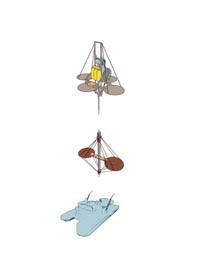 This image represents three of the primary components of the Space Elevator - Platform, Lifter, and Counterweight. The fourth component is the carbon nanotube ribbon, upon which loads ride. The fifth is the propulsion system, a laser in this case.
This image represents three of the primary components of the Space Elevator - Platform, Lifter, and Counterweight. The fourth component is the carbon nanotube ribbon, upon which loads ride. The fifth is the propulsion system, a laser in this case.
Click on each image to view medium resolution.
All images in this section are © Copyright LiftPort, and may not be used without their permission.
Large Version
NN: What would the SE be used for? Off-world migration, space-tourism, asteroid mining, launching packages (such as satellites)? How does it benefit each?
As the SE develops, these are the things it will affect first.
In order:
- Communication Satellites
- Solar Energy Satellites
- Expanded Space Stations for
- Communications
- Repair facilities for sats
- Pharmacuedicals and biosciences
- Moon/Mars/Asteroid Exploratory Missions
- Settlement Missions
All of these will be within the first 5 years of completion and standard cargo delivery. Once that basic infrastructure is in place, we have expanded into a dedicated 'up' and a dedicated 'down' ribbon of 5 tons of cargo, 200 trips a years. Then we do the same thing and build up a 20 ton up/down system. Once that full system is in place, things get really 'fun.' Price per pound drops like a brick, because we have so much spare capacity. That's when the tourism, mass migration/colonization, asteroid mining, medical labs/burn units/convalescent centers open up. Personally, I am looking forward to hosting the Olympics up there.
NN: What advantages does having a SE bring to the country or business that builds the first one?
It means limitless, safe, simple, affordable access to space, with a predictable cargo schedule. It means the cargo can become an enormous increase in energy resources (huge solar energy satellites supplying clean - endlessly renewable - power back to earth); expanded, permanent settlements on the moon and mars and asteroids, and a stepping stone beyond, into the 'wild black yonder.' It means expanded communications to everyone on the planet - phone, video, internet, because of a greatly increased commsat infrastructure. It means bio-science advances that may allow us to live longer and in greater comfort in our old age, and better, higher purity medicines that we will use in our goal of a full and healthy life. So these advantages would go to the whole planet, really.
The company that maintained the system would probably be very profitable as well.
LiftPort Group intends to be the company that leads the international consortium in the construction and operations/management of the first Space Elevator. Once the first one is established, I believe many more will be built, because it is the only space transportation infrastructure that can apply economies of scale. They actually get less expensive the more you build, which also means the price/kilo can fall dramatically, as expanded systems are built.
There are significant commercial barriers to entry for whomever tries to build the 2nd one, if they try to do it without the cooperation of the people who built the first one.
LiftPort Concept Anchor
Large Version

NN: What budget do you believe is necessary to make it happen within 10 years?
Well, we've never said it was possible in 10 years. We have consistently stated 15 years (from when we started last year). So, take a look at our countdown clock on our website - we have about 14 years to go.
It will take about $7-10B. The brief outline of expenditures looks something like this:
- 2018 system complete - $1B
- 2015 system deployment - $2B
- 2009 design and fabrication of components - $5B
- 2004 financing, research/development, social/political/legal support - $2B
And it's important to notice that we only spend 20% of the budget in the first 1/3rd of the time. It's during that crucial period that we test and expand our knowledge and determine if we can or cannot actually accomplish our goal. If not, then the money spent will still have huge commercial spinoff value, (which will more than pay back its investment) and if we can build it, all the better, the risk has gone way down, based on our newly acquired science.
|
Using a laser beam to boost the climbers into space is doable, said Harold Bennett, president of Bennett Optical Research, Inc. of Ridgecrest, California. "If you do it right, you can take out 96 percent of the effect of the atmosphere on the laser beam through adaptive optics," he said. The strength of the pulsed laser beam is less than the intensity of the Sun, so birds, airplanes, or human eyes wouldn't be affected, he said.
— Leonard David The Space Elevator Comes Closer to Reality (cont.)
|
NN: Most people who have read about the SE know that producing substantial lengths of carbon nanotube ribbon remains one of the greatest hurdles. Has any recent science given hope that this hurdle will be overcome?
Did you see the work that was released recently from Los Alamos National Labs (link)? That ribbon isn't as far away as most people think.
NN: In your opinion, if a full-scale effort was launched today, how long before the first SE could be built?
Look at our countdown clock. we are serious about it. Lots of big projects, space, factories, tunnels, bridges say something like "in 20 years we'll..." and that gives them a lot of room to fudge the numbers and let deadlines slip. We don't want to be that kind of project.
We've set a date, and that is what we are working toward.
Many people have laughed at us about this. That's fine, my team knows how many days are left and our internal motto is 'Every Day Is Precious.' We know people are counting on us to make this happen, and we don't intend to let them down.
Ocean Platform
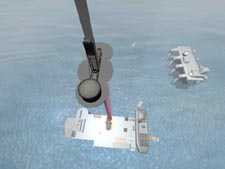
The ocean platform, as seen from the lifter as it crawls up a ribbon.
Large Version
|
NN: Who's for it, and why?
The day we open for business, we will have 10x the current global launch capacity... that means that basic supply and demand forces will apply, and the cost per pound will drop dramatically. We are anticipating $400/lb ranges, and some people are predicting it could go lower than that, once the 2nd and 3rd elevators are built.
So, who will it benefit? Anyone that wants low-cost, high-volume access to space. This would mean, for instance, that smaller schools could do space-based research. Instead of a huge budget allocation, smaller schools could open up new branches of research, because the costs of access have dropped so much. What this means is that we could see significant advances in biosciences, pharmaceuticals, electronics and material sciences. Also, developing nations would benefit in the same way. Countries that didn't have any realistic ability to access space could launch satellites that would help monitor weather and natural resources management systems. Of course, let's not forget that this opens the way to Mars and the Moon in a meaningful way. Colonization becomes possible, so too, is the collection of solar energy from space and bringing that power back down to earth. Add to that the massive expansion of telecommunications systems - so if YOU want lower energy prices, from a clean, renewable source, if YOU want truly global telephone/internet access, and if you want the ability to dream of opening up a new frontier, the the SE affects YOU directly.
Let's not forget that the SE could be used for fun, tourism and hotels, and as you can probably imagine, some pretty 'extreme sports.' People are even talking about developing an 'Olympics' type event in space.
|
Cost of putting one pound of anything into space now - $10,000 ($22,000 per kg)
Potential cost of putting same pound into space with the space elevator - $10
|
Of course, I don't want this response to be perceived as 'spin-control' of the project. There are some defense applications as well, which I am not going to go into details on, but it exists and needs to be recognized. I want to be clear, though, that we are not building a weapon, we are building a tool for future generations of the earth.
In the short-term, within 5 years after commercial completion, I am skeptical about asteroid mining, as I understand it now. As the SE evolves into multiple heavy-duty systems, that may change. But that is not being factored into my re-payment schedule for financing this project.
Lifter in Clouds

Lifters: Robotic cargo and construction cars.
Large Version
|
NN: Who’s against it, and why?
So far as I know, no one is 'against it.' Some people have said that this will be the 'death of the rocket industry' and I strongly disagree. I think there will be a huge boost in that field. Never forget that we are a 'point A to point B' transportation system. If you want to get to point C (and many of the really great things you can do in space will require that) the only way to get there is with rockets. So, with the completion of the SE, there will be a huge increase in the demand for small, efficient rockets. Also, who better than the rocket builders to build the large, industrial sized facilities - manufacturing, hospitals/retirement/rehabilitation centers, hotels for tourism, off-world exploration, and large solar arrays.
While some people warn us that the Boeings and Lockheed Martins of the world will want to squash the concept, we feel that they might be essential long-term partners, and that they will help nurture the growth of the space-based economy.
NN: What technologies do we need to develop to make it happen?
Tether
This might be much closer, thanks to Dr. Zhu's work at LANL. Still, it's hard to go from 4cm to 100000km.... but what his (and many other researchers) work is proving, is that we have a good set of theories and that by following them, significant progress is being made on a weekly basis. So, yes, it will be hard, but also, we are making progress - fast.
Propulsion (power) Electric vs. Chemical
This is not as hard as many of the other issues. Making a big power beaming system is very challenging, but the rockets we will need are well understood and commercial off the shelf technologies. The power beaming is an issue, as it requires advances in both lasers and thin-film, high-efficiency solar panel technologies. What I find interesting is that economically, our project becomes a driver for all these advances, and then once we achieve the new tech-levels, that becomes useful to industry in the 'down to earth' marketplace. There are lots of uses for these technologies, such as homes covered with inexpensive, easy to apply solar panels, that are capturing clean, renewable energy.
Space Junk and Asteroid Avoidance
This will be hard as there are a lot of debris up there. We will be hit by the 'little' pieces (which is part of the reason for a ribbon design and not a cable - its better able to take the hits). The 'big pieces are a problem. To avoid this, we are going to have to have and active radar system that is very sensitive.
|
Laboratories throughout the world are rapidly gaining atomically precise control over matter. As this control extends to an ever wider variety of materials, processes and devices, opportunities for applications relevant to NASA's missions will be created. This document surveys a number of future molecular nanotechnology capabilities of aerospace interest. Computer applications, launch vehicle improvements, and active materials appear to be of particular interest. We also list a number of applications for each of NASA's enterprises. If advanced molecular nanotechnology can be developed, almost all of NASA's endeavors will be radically improved. In particular, a sufficiently advanced molecular nanotechnology can arguably bring large scale space colonization within our grasp.
—Al Globus, David Bailey, Jie Han, Richard Jaffe, Creon Levit, Ralph Merkle, and Deepak Srivastava.
NASA applications of molecular nanotechnology Published in The Journal of the British Interplanetary Society, volume 51, pp. 145-152, 1998.
|
|
Weather: Lightening and Hurricanes Avoidance
While this comes up a lot as a 'big' problem, really it doesn't look like it's going to be. Sure, there will be lots of testing to validate our theory, but so far, this looks like a non-issue. Just place the system in a proven location that is benign, and then make it mobile by using a ship (the Liftport) as the earthly connector. By placing it on the equator, we negate all the big storms, because as they get closer to the equator, they loose all their force and fail.
Terrorists Threats
Our number one question is "what if a plane flies into it?" and I think that question stems more from the fear in the American psyche than it does as an actual scientific question. We are hundreds of miles from air/sea routes. We will have outstanding radar ability to detect incoming threats. And we have solutions to counter them.
On the other hand, this is not a good target for terrorist. Think about the term - terror means it has to have a humanistic target. Damaging the ribbon is a minor economic event, not even worth the effort of these groups. The Superbowl is a much more 'juicy' target. If they break the ribbon, we loose a few weeks of cargo transport, we repair it, and get back to work. Of course we have done our homework regarding disaster recovery, just in case.
Thermal Flux
It's where there is a different thermal expansion/contraction rate of materials between the CNT and the matrix that surrounds the CNT. It's a pretty big issue because as the ribbon moves into and out of the sunlight, it's going to heat/cool at an astounding rate. This will fatigue the ribbon; the problem is, we can't even begin to model this, until we have a better understanding of the ribbon/composite itself.
So this problems waits for a while, and then we tackle it.
Of course there are other issues - LPG lumps them into 4 super-categories:
- Science/Technology
- Political/Societal
- Legal
- Finance/Commercialization
Dr. Brad Edwards has been primarily focused on the science/tech, and LPG has been working on the other three. Of course you could have all the problems in 3 of the 4 solved, and still not be able to build this thing. In this case, it's an 'all or nothing' concept. All the parts have to work, in order to build and operate the SE. What's important to point out, though, is that it is like this for EVERY construction project - bridges, tunnels, a new city hall, an industrial factory. All of these have to solve the same basic sets of problems. The difference of course is that the bigger the project, the more issues there are to sort out.
This is a big project, so it is correspondingly complex.
Lifter Ascending

The Earth, as seen from the lifter.
Large Version
|
NN: Why isn't the U.S. government building one?
NASA Institute of Advanced Concepts was the original funders of the ground-breaking research. Through Marshal Space Flight Center, Los Alamos National Labs and many universities - the US government IS funding continued exploration of the idea. The most recent is the US Air Force Academy - they have signed on as a research partner, to continue the examination of critical systems. The University of Texas has also decided to lend a hand by getting their MBA program involved with evaluating our commercial model and advancing the business of building and operating the SE.
The fact is that I don't believe the US government will - or even should - build this. It will be built by a for-profit company that sees a large return on investment, in the future, for the risk they are taking now. LiftPort Group has a business model that will help make this possible; we are modeling this effort on the early transcontinental railroads.
They were privately financed, counted on governmental contracts for transporting mail to help ensure the repayment of the bonds that were issued. We intend to secure similar contracts from the US and other nations for low-cost, reliable, safe and consistent scheduling of cargo to space.
LPG is constantly looking to add to its research partner list, and to expand that list overseas and get other nations involved.
NN: What is International Public Inclusion (IPI)?
International Public Inclusion is exactly what it sounds like: an invitation to every human being to participate in the development of the Space Elevator in some manner. The Space Elevator is a tremendous project that will have an impact on the entire planet, not just the United States. While the project will be led by our US company, LiftPort Group feels humanity as a whole has a right to be involved in such a project. In order to provide as much benefit as possible from the Space Elevator, LiftPort Group would like to see many individual, academic, governmental, non-governmental, and corporate entities get involved.
LiftPort Group is dedicated to providing a venue to facilitate its policy of IPI via the LiftPort Group website (www.liftport.com). By offering such a forum, certain technical, legal, business, and philosophical challenges may be addressed before they become problems. LiftPort Group will create an international public dialogue through our online interactions and will also begin compiling information and archives detailing the development of the Space Elevator.
Cross views of the Counterweight
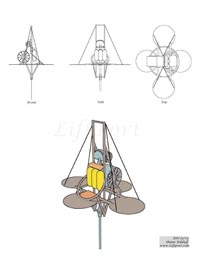
Rather than a captured asteroid as a counterweight, the Space Elevator will use it's own left-over construction equipment.
Large Version
|
|
Michael J. Laine is the President and Chief Strategic Officer of the LiftPort Group "The Space Elevator Companies."
As president and founder of LiftPort Inc., the company devoted to the commercial
development of an elevator to space, Michael Laine is turning a lifetime interest in space
into a professional venture.
Laine brings more than 15 years of business management and development experience
for the technology, financial services and military markets, with the past four years
devoted to space technology and development.
Prior to LiftPort, Laine was co-founder and president of HighLift Systems, a Seattle-based
company that received funds from NASA's Institute for Advanced Concepts (NIAC) to
research building an elevator to space. Prior to creating HighLift Systems, Laine was
chief executive officer and founder of TEKnology-Laine LLC, a Bremerton, Washington-based
Internet conglomerate, which he owned and operated from 1996 to 2001.
Laine has been recognized many times for his leadership in civic and community
development, and has served on several non-profit boards. Laine studied Business
Administration at Boston University.
LiftPort
245 4th Street
Suite 508
Bremerton WA 98337
360.377.0623 - vx
360.824.7394 - fx
laine@liftport.com
www.liftport.com
Join LiftPort Forums
Sign up for LiftPort Newsletter
|

Dr. K. Eric Drexler
The Space Elevator - Another View
NN: As you understand it, what technical hurdles remain before we can hope to build the Space Elevator? What's changed recently that might advance (or delay) the timeframe?
To the best of my knowledge, there has been no engineering design and analysis that addresses a fundamental problem with the high tension structures in the space elevator concept: safely dissipating the elastic energy released when a fiber snaps (whether as a result of defects, meteoroid impact, or whatever). Blaise Gassend of MIT has raised this issue (link), but only discusses the temperature increase that would result if the elastic energy were converted to thermal energy. Before the elastic energy can be thermalized, however, it will first accelerate the end of the fiber to a high speed -- kilometers per second. A polymer binder will not prevent this, because it will be far to weak to restrain the broken end of a high-tension fiber. One would expect a fast-moving fiber end to damage and break adjacent fibers, causing a failure cascade.
If there is a design and analysis that shows how the elastic energy in broken fibers can be dissipated without a causing a failure cascade, it should be publicized. Absent such a design and analysis, there is not yet a workable proposal on the table.
NN: Scientists are manufacturing CNTs in various new and unique ways, each of which increases either their strength and length, or one of their other remarkable properties. Some say that within just a few years we should be able to manufacture them in lengths and strengths adequate to fulfill the needs of the SE. Given what you understand to be true, what do you suppose the future holds concerning humankind's race into space via a thousands of miles tall elevator?
A space elevator is just one of many ways of using energy to lift and accelerate objects. It has no obvious advantages in speed, efficiency, or safety. Molecular manufacturing will make space flight inexpensive, even if terrestrial space elevators prove to be infeasible. There are more conventional to use inexpensive, high-performance components to get into space at low cost.
For example, molecular manufacturing will enable the production of high strength-to-weight-ratio structures, high power-density engines, and other useful components for relatively conventional aerospace systems. A vehicle using such components and LOX/LH2 rocket propulsion (using the same fuel as the Shuttle main engines) can carry four passengers to orbit in a vehicle with a fully fueled mass as lift-off no larger than the mass of an SUV. The anticipated cost of products made by molecular manufacturing is in the range of tens of cents per kilogram or less, making a vehicle of this sort quite affordable -- hundreds, not thousands of dollars per passenger.
Since the U.S. nanotechnology funding establishment has for years worked to suppress rather than promote direct research in molecular manufacturing -- denying its feasibility, smearing it by equating desktop nanofactories with "monster nanobots", promoting misunderstandings involving imaginary "magic fingers", intimidating potential researchers, and so on -- the U.S. suffers from a unique, self-inflicted handicap in the field. Unless this situation changes quickly and dramatically, we should expect other nations to lead in molecular manufacturing, and to dominate all frontiers that it will open.
|
K. Eric Drexler, is an author, theoretical researcher, and policy advocate focused on emerging technologies and their consequences for the future. Noting that technological advances have caused some of the deepest transformations in human history, he studies emerging technologies with the power to cause future global transformations. Rather than concentrating solely on the immediate laboratory aspects of emerging technologies, where many scientists work in an array of narrow fields, Eric Drexler has chosen to focus on longer-term developments and their potential economic and social consequences, a broad area often neglected or overshadowed in the study of technological change. An advocate of long-term perspectives in policymaking, Eric writes and lectures widely on the implications of emerging technologies for our future. He is Founder, Chairman Emeritus, and Chairman of the Board of Advisors of Foresight Institute, a non-profit educational organization that works to help society prepare for emerging technological revolutions.
Personal technical site: e-drexler.com
|
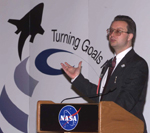
Dr. Thomas L. McKendree
Another View
NN: Do you believe a Space Elevator is feasible and/or likely?
Space elevators are feasible if they are not infeasible. They are structurally infeasible with steel. CNTs offer sufficient strength-to-weight to make them structurally feasible. Landis and Cafarelli (1) showed that a tower-skyhook combination can be much more mass efficient, and that remains true on Earth using CNTs. The main operational issue is dealing with everything else in orbit that could hit the elevator. Some solution (e.g., moving the space elevator slowly to dodge) may be feasible. Finally, it has to be financially feasible. That depends on the costs and the market.
As for likely, I'm not sure. There's a good chance that a lower tower-only structure will be deployed and used before a full space elevator (in tension through geosynchronous altitude). My guess is that a full space elevator will at best be like the Panama Canal-it eventually became very useful for shipping between the Atlantic and the Pacific, but transportation and Pacific-rim development was built up quite a bit before the canal was built. Similarly, a space elevator may be successful, and if so it would greatly improve transportation to space, but we may develop space a great deal using conventional rockets first.
NN: As you understand it, what technical hurdles remain before we can hope to build the Space Elevator? What's changed recently that might advance (or delay) the timeframe?
A whole host of details must be worked out. OTOH, I am encouraged by the work of Bradley Edwards, but a great deal of additional work remains before a demonstration elevator could be flown.
NN: What other nano-enhanced technologies may pave the way to off-earth travel? Surely all those that are soon to come will take advantage of the high strength-to-weight ratio of CNTs.
Higher strength-to-mass ratios of materials can improve conventional rockets and their payloads. Advancing micro/nanotechnology in computers improves the performance of payloads. Just by making people generally richer and making it generally cheaper to build things, nanotechnology can improve the potential for space development. Reflector-based solar panels using straightforward nanotechnology could increase the power per kg of solar panels by orders of magnitude, and that would allow vastly better solar-electric ion engines.
NN: What else do you think is important regarding the reasons why and the ways that humankind will leave Earth?
"Why" is to use the resources beyond Earth. Solar power is a great energy source, but most Sunlight misses Earth. Most of Earth's mass is well below the surface, not doing much beyond generating gravity and a magnetic field, but we could disassemble and fully use asteroids. John Lewis (2) estimates that the main belt asteroids alone would be enough to support over 14,000,000 billion people, rather than the current 6 billion on Earth now. An eventually we want to spread civilization to the stars. Dispersed enough, we can survive disasters that would now make humans extinct.
(1) in JBIS:52, pp.149-154, 1999
(2) in JBIS:50, pp.51-58, 1997
|
Thomas L. McKendree earned a Ph.D. from the University of Southern California, where
he studied systems architecture in the Department of
Industrial and Systems Engineering. His dissertation, Technical and
Operational Assessment of Molecular Nanotechnology for Space Operations, examines
molecular
nanotechnology and space, with a focus on space
manufacturing and
transportation. His published papers related to molecular nanotechnology include:
He is a Senior Associate of the Foresight Institute, where he has been a member since 1987. He is a member of the International Council on Systems
Engineering, the Alcor Life Extension Foundation, and was President of the
Molecular Manufacturing Shortcut Group,
a special interest chapter of the National Space Society. He is a former
keyholder of the MIT Science Fiction Society.
Tom McKendree is also a full-time employee of the Raytheon Systems
Company, where he supports efforts with RTCA
and GPS III. Previously he has worked on ballistic missile defense, led deployment analyses for the
Automated Highway System program, and an early study of the Revolution
in Military Affairs.
|

Dr. David Tomanek
Another View
The Space Elevator is a useful concept, allowing massive objects
to leave the gravitational field of planets. The rotation of the
planet, a necessary prerequisite, decides about the practicality
of the concept for a particular situation. The following reasoning
explains why the Moon is not very useful to test the Space
Elevator idea.
The tension in the cable is provided by the centrifugal force,
exerted by an object that is attached to the end of the cable,
which is rotating at a constant angular velocity. Attach a stone
to a string and swing it around to feel the tension in the string.
Let us consider a cable of equal length, with the same mass at the
end, attached to the Earth and the Moon. Ignoring gravity and
differences in the radius of the Moon and the Earth, the tension
in the cable is proportional to the angular velocity squared. The
Moon rotates thirty times slower than the Earth. The tension in
the Moon cable would be 900 times smaller.
Now, gravity always reduces the tension (remember: no tension in a
"cable" to a geostationary satellite). No elevator on a cable with no
tension. The reduction of cable tension on the Moon is 6 smaller
than on the Earth. Still, 900/6 is a big factor. For the same tension,
the Moon cable would have to be 100 times longer, or have a 100 times
larger mass attached to it.
You can ask -- do we really need the same tension? Not really; the
tension on the Moon could be a factor of 6 smaller to reasonably
escape the gravitational field. This gets us down from 100-200 to a
(still considerable) factor 20.
NASA believes in an Earth elevator within the next 50 years.
|
David Tomanek is a Professor of Theoretical Condensed Matter Physics at Michigan State University. His main research interest is to understand fundamental properties of nanostructured materials using advanced numerical techniques.
He is considered an expert on CNTs.
See also Nanotube Research in
David Tománek's Group
|

Dr. J. Storrs Hall
Another View
NN: As you understand it, what technical hurdles remain before we can hope to build the Space Elevator? What's changed recently that might advance (or delay) the timeframe?
If such a structure could be built at all it would almost certainly require molecular manufacturing capability. The reason is simple: the structure would require at least ten thousand, and more likely 100 thousand, tonnes of near-atomically-perfect buckytubes or other graphite cable in a tapered form on the order of 80 thousand kilometers long.
The theory behind the skyhook makes clear a number of other difficulties besides merely fabricating its material: It is essentially a satellite placed in geosynchronous (GEO) orbit, long enough on one end to reach the ground, and on the other to balance the ground arm and keep the center of mass in GEO. Among other things, you have to get it up there somehow. It has to be near the equator. It will get hit, ultimately, by almost any satellite not in GEO, meaning it is essentially mutually exclusive with satellites.
NN: Scientists are manufacturing CNTs in various new and unique ways, each of which increases either their strength and length, or one of their other remarkable properties. Some say that within just a few years we should be able to manufacture them in lengths and strengths adequate to fulfill the needs of the SE. Given what you understand to be true, what do you suppose the future holds concerning humankind's race into space via a thousands of miles tall elevator?
It would require mature molecular manufacturing, see above--but that would give us personal spaceships anyway. I don't expect one in the next 50 years.
NN: What other nano-enhanced technologies may pave the way to off-earth travel? Surely all those that are soon to come will take advantage of the high strength-to-weight ratio of CNTs.
Molecular manufacturing will make family-sized and family-budget air-launched SSTO's feasible (Single Stage To Orbit vehicles). For high volume freight, my launch tower concept (see The Space Pier) might be useful.
NN: What else do you think is important about the reasons why and the ways that humankind will leave Earth?
The Earth's biosphere is unique and special in the universe. If it's all the room we have, we'll ultimately pave it all over. If we move into space and make habitats among the asteroids, Earth will be 1% of 1% of what we have -- much easier to save it as a park and preserve.
NN: If you could address the entire world, in the language and terms best suited to the individual, what would you tell them about your vision of the next 50 years, and the changes we are likely to see that were enabled by our understanding of the nanoscale?
Imagine living in England in 1800. It's a world of horses, handwoven cloth, and sailing ships -- the world of Benjamin Franklin. Fifty years later, it's a world of locomotives, factories, and steamships (not to mention the telegraph) -- the world of Sherlock Holmes. That's about to happen again.
|
J. Storrs Hall is a Fellow of the Molecular Engineering Research Institute (mol-eng.com) and the Chief Scientist at Nanorex Inc.
Known as the originator of the Utility Fog concept, "Josh" is also a Research Fellow of the Institute for Molecular Manufacturing [IMM]. He has a background in computer science, particularly parallel processor architectures, artificial intelligence, particularly agoric and genetic algorithms as used in design, and reversible computing, and his research interests include molecular nanotechnology, particularly the theory of self-reproducing machines, and the design of useful macroscopic machines using the capabilities of molecular manufacturing.
|
P-O'd At IPO's or 'Why the Nanosys IPO now would have been bad for Nanotech' |
 |
|
The industries that nanotechnology will likely have a disruptive effect on in the near term include the following:
(Amounts are Billions of US Dollars)
|
$1,700 |
Healthcare |
|
$600 |
Long Term Care |
|
$550 |
Electronics |
|
$550 |
Telecom |
|
$480 |
Packaging |
|
$450 |
U.S. Chemical |
|
$460 |
Plastics |
|
$182 |
Apparel |
|
$180 |
Pharmaceutical |
|
$165 |
Tobacco |
|
$100 |
Semiconductor |
|
$92 |
Hospitality / Restaurant |
|
$90 |
US Insurance |
|
$83 |
Printing |
|
$80 |
Corrosion Removal |
|
$57 |
US Steel |
|
$43 |
Newspaper |
|
$42 |
Diet Supplement |
|
$40 |
Diet |
|
$32 |
Publishing |
|
$30 |
Catalysts |
|
$27 |
Glass |
|
$24 |
Advertising |
|
$18 |
Cosmetics |
|
$13 |
Chocolate |
|
$10 |
Battery |
|
$5 |
Blue Jeans |
|
$4 |
Khakis |
|
$2.8 |
Fluorescent Tagging |
|



Our Review
The Superswarm Interview
The Superswarm Option
Nanoveau - This column will cover the science, the speculation, and (occasionally) the politics of nanotechnology and related topics. If you want to know what nanotech is about, and how and why it will change everything we know-Nanoveau is for you.
|
|
Many were upset when Nanosys withdrew their IPO in early August 2004 after announcing their IPO end of April 2004, least of all CEO Larry Bock. However, it remains clear that market conditions were not ready for an IPO of a company at that stage of progress. Nanosys was without actual product and sales and did not promise them any time soon. Many consider Nanosys the poster child of successful nanotechnology startup companies. However, there are many other nanotechnology startups, some with similar business models and some even with sales revenues that may have just as good technology and potential but not as good press.
The market was and still is P-O'd at IPO's for companies without real product and sales revenues. This was because the market was too soon out of an economic downturn due to overvalued dot.com and biotech companies, some of which spent money like there was no tomorrow, and some of which also did not have real sales yet. The aftermath of those bubbles bursting was exacerbated by the 9-11 tragedy. Only a few of those companies such as Yahoo actually succeeded while the rest fell by the wayside as casualties of dot.com and biotech.
Nanosys would not have seen any revenues soon after this IPO. If Nanosys had succeeded in going IPO, its stock price would have dropped significantly soon afterwards. There would have been many a disappointed public shareholder feeling they had been had and selling off their shares a year into ownership. Public shareholders have much shorter-term investment horizons and shortsighted views these days in terms of making money from stock of publicly held companies. The public is less risk adverse than angels and VC's. The only people who would have made any money on the IPO were the early VC investors selling off their shares at the IPO.
As Nanosys was being positioned as the great nanotech hope that would pave the way for nanotechology's legitimacy on Wall Street, Nanosys' failure on the stock market would have burst a perceived nanotech bubble. The problem here for nanotechnology and companies in this space is bad news travels fast and goes away even slower. This would have poisoned the market mentality for any other upcoming and perhaps more promising and better positioned nanotech companies that should be going public in an IPO or for other nanotech startup companies trying to raise funding for the next few years. Nanosys would have left a bad taste in the mouth of the public for future nanotech deals. It would then become even more difficult than it was lately to raise the most simplest of funding for any other nanotech startup. Timing is just as important in the startup world and having to wait another few years for appropriate funding could kill many companies with potentially disruptive technology. With the withdrawal of the Nanosys IPO, the hype bubble then deflated to the more reasonable and manageable proportions of the fledgling industry that it is.
Here is where I start to digress from my original point of this piece but bear with me. Over time, in the VC's mind, an exit strategy is successful as long as they recoup their investment and make money from it and then go on to invest in the next venture. However, this is not considered a success for the person who bought their shares and then watched their value drop because the company's potential was overhyped and overvalued when they bought it. In some people's mind in the more extreme case, this could constitute fraud. Some might even argue there is a fine line between overvaluing and overhyping company performance and potential considering we've heard the Enron, Worldcom and Tyco stories to make us just uneasy enough to lean that way. What makes us uneasy is how easy it is to do that and allowed to do that because such practices are so ingrained in the corporate culture. Every investment deal that comes across investors' desks is assuredly labeled as "overvalued".
From a big picture perspective, a successful entrepreneur and/or CEO is one who creates, leads and manages a company whose value holds through the good and bad times because he is a good leader and strategist for the company. Is a CEO successful just because he was able to bring a company to a successful IPO? What if the company tanks afterwards?
Some believe that being able to make money on the IPO even though the company in the long term fails still makes for a success story and a successful CEO. A CEO is considered successful if he makes a lot of money for its investors via an IPO even though the company tanks in the long run? Is there something wrong with this logic?
Somewhere along the line, the other half of the equation that got lost in the striving for excess is that the company should actually be expected to maintain its projected value after the IPO. Of course, on the other hand, as investors, we all have to do our own due diligence before buying shares in anything. We also must shoulder some responsibility as investors. An IPO should not be used to recoup investment in a bad opportunity for investors by passing on the bad news to the public. An IPO should be used to cash in a successful investment.
Nanosys may be the poster child of nanotech, but it needs to grow up a little more, perhaps reach adolescence first by proving it can make some real product and sales, before moving out on its own into the public domain. It is a good company but it's just not ready to go public. Their marketing team is very good and they have very good network and lots of funding. However, Nanosys' legs are still taking its first steps. If its legs are not strong enough to support itself, it could fall and hurt itself. With the current market mentality, for nanotech and for any other industry for that matter, we should take the cue from Orson Wells' famous line for Paul Masson wines in their commercials where there should not be an IPO before its time.
Stay tuned for next month's article.
|
Dr. Pearl Chin has an MBA from Cornell, a Ph.D. in Materials Science and Engineering from University of Delaware's Center for Composite Materials and B.E. in Chemical Engineering from The Cooper Union.
Dr. Chin specializes in advising on nanotechnology investment opportunities. She is also CEO of Red Seraphim Consulting where she advises investment firms and startup firms on the business strategy of nanotechnology investments. She was Managing Director of the US offices and co-Managing Director of the London offices of Cientifica. Prior to that, she was a Management Consultant with Pittiglio Rabin Todd & McGrath (PRTM)'s Chemicals, Engineered Materials and Packaged Goods group.
Dr. Chin will be advising the Cornell University JGSM's student run VC fund, Big Red Venture Fund (BRVF), on investing in nanotechnology.
She is a Senior Associate of The Foresight Institute in the US and was the US Representative of the Institute of Nanotechnology in the UK. She was an alternate finalist for a Congressional Fellowship with the Materials Research Society.
She was also a Guest Scientist collaborating with the National Institute of Standards & Technology (NIST) Polymer Division's Electronic Materials Group under the US Department of Commerce.
Dr. Chin is a US Citizen born and raised in New York City.
She can be contacted here.
|
Quotes
“The way you get rich guys involved,” she explained, “is you have an exciting thing, and the space elevator is exciting, but you need to get your technical act together. You need fundable technology, things where you can see a business proposition. Then, the rich guys will come in, and they’re willing to take a lot more risk with their money than normal people.” With all the potential spinoff technologies, including carbon nanotubes, possible with a space elevator, “it should be a slam dunk.”
—Donna Shirley, the former head of NASA’s Mars Exploration link
"The risk of a Challenger or Columbia shuttle tragedy is basically removed. You don’t have the large energy transfer type events of a rocket launch or reentry. No need for heavy-lift vehicles. You can eliminate a lot of the other development risks," (Dr. Bradley) Edwards concluded. "The whole space exploration program could be very straightforward and become successful pretty quick." link
The main obstacle keeping the human race from colonizing the solar system is the first 160 kilometers. Climbing out of Earth's gravity well is difficult, dangerous, and extremely expensive. Today, it costs over $10,000 to put just a single pound of payload into orbit, and a single flight of the Space Shuttle costs over a half billion dollars.
Yet this is not a situation unique in the history of exploration. In the early 1800s, overland travel across the American Frontier was equally arduous and wallet-heavy. Lewis and Clark's famous expedition proved to be two years of expensive preparations and frustratingly slow progress. Some scholars at the time thought it might take over 800 years to colonize the American West.
Yet by the end of that century a new technology -- the railroad -- had accomplished the task in only a few short decades. Our difficulties in achieving orbit might be solved by a similar method -- by building a railroad track straight into space.
Orbital Railroads: Beanstalks and Space Fountains
—Paul Lucas
Why do it?
- Improving the intelligence-gathering capacity of America and its allies.
- Acquiring enhanced defense capabilities against emerging military and terrorist threats.
- Long-term prospect for new and more secure energy supplies.
Doing all of the above better, faster, cheaper than with alternative methods.
—James M. Gardner
From Our Molecular Future: How Nanotechnology, Robotics, Genetics, and Artificial Intelligence Will Transform Our World, by Douglas Mulhall:
-
What happens to the monetary system when everyone is able to satisfy his own basic material needs at very low cost?
-
How would we use cash when digital manufacturing makes it impossible to differentiate a counterfeit bill or coin from the real thing?
-
What happens to fiscal policy when digital information, moving at light speed, is the major commodity?
-
How fast will monetary cycles move compared to, say, the ten- or twenty-year cycles of the late twentieth century, when products and patents go out of date in a matter of months instead of years?
-
What happens when we don't have to worry about trade or social services for our basic needs, because most of what we need is provided locally with digital manufacturing, and the biggest trade is in information?
-
How do we control the excesses of the ultrarich, the overabundance of the molecular assembler economy, and the challenge to intellectual property laws created by intelligent, inventive machines?
-
What happens if half of all jobs are made redundant every decade?
-
What happens to the War on Drugs when there's no import, export, or transport of contraband because drugs can be manufactured in a desktop machine using pirated software downloaded from the Internet?
-
What happens to democratic controls when individuals can get as rich as small governments in a year or so?
-
What's the relevance of insurance if many things are replaceable at very low capital cost, but liabilities from software are potentially unlimited?
-
How should organized labor react when molecular assemblers and intelligent robots eliminate most manufacturing jobs?
-
What is the nature of work going to be?
-
What happens to land prices when an individual can build a tropical farm under a bubble in North Dakota, and get there from New York in an hour?
-
What happens when everyone can go everywhere, whenever they want, and work from wherever they want?
Return to Top
Useful Links
Elevator 2010
Conspicuous Construction
Space Elevators, Space Hotels, and Space Tourism
The Space Elevator
NIAC Phase II Final Report March 1, 2003
Bradley C. Edwards, Ph.D.
liftwatch.org
Space Elevator Books, Documents and References
Notes from the Third Annual Space Elevator Conference June 2004
The Space Elevator: 3rd Annual International Conference
Frankenstein's Elevator Alternate 'mode' of SE1 construction
Scientists launching spacey idea A Dave Barry sendup of the SE. A funny read, and as Howard Lovy said "Great stuff, whether you're an elevator believer or not. If you hate to see nanotech mocked like this, get over yourself."
Space Elevator: Momentum Building Leonard David
Space Elevator: Next Stop, Earth Orbit Leonard David
Space Towers
Space Elevator Concept
NASA applications of molecular nanotechnology
The Economics of the Space Elevator Eric Westling (PPT)
Space elevator contest proposed ‘Elevator:2010’ aimed at encouraging technology development.
Elevator 2010 Climbing The Sky

Return to Top
IN THE NEXT ISSUE
Issue #17 will cover Investments. It will land in your mailbox November 1st, 2004.
Infamous Quotes:
"This 'telephone' has too many shortcomings to be seriously considered as a means of communication. The device is inherently of no value to us." Western Union internal memo, 1876
"Heavier-than-air flying machines are impossible." - Physicist and mathematician Lord Kelvin, President of the British Royal Society, 1895
"Everything that can be invented has been invented." - Charles H. Duell, Director of U.S. Patent Office, 1899
"There is no likelihood man can ever tap the power of the atom." - Robert Milikan, Nobel Laureate in Physics, 1923
"Theoretically, television may be feasible, but I consider it an impossibility-a development which we should waste little time dreaming about." - Lee de Forest, inventor of the cathode ray tube, 1926
"I think there is a world market for maybe five computers." IBM's Thomas Watson, 1943
"Landing and moving around on the moon offer so many serious problems for human beings that it may take science another 200 years to lick them." - Science Digest, August 1948
"Computers in the future may weigh no more than 1.5 tons." Popular Mechanics, 1949
"There is no reason anyone would want a computer in their home." Ken Olsen, Digital Equipment Corp, 1977
And the lesson is? It's a tough game to call.
Need advice? Check out NanoStrategies
© Copyright 1999-2004 7thWave, Inc. All rights reserved. More information on copyright, and disclaimers regarding the content of this newsletter can be found here
|










